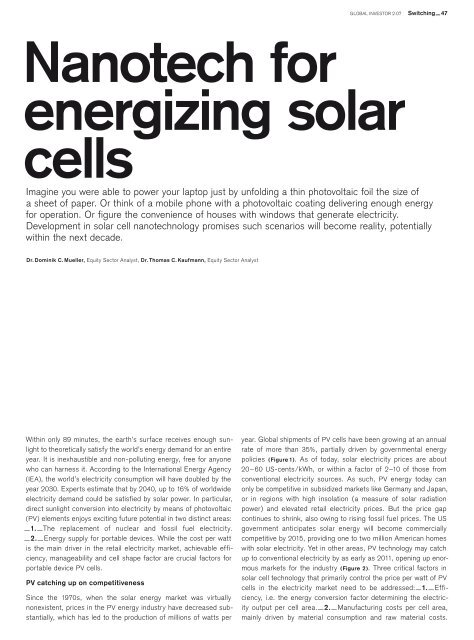You also want an ePaper? Increase the reach of your titles
YUMPU automatically turns print PDFs into web optimized ePapers that Google loves.
GLOBAL INVESTOR 2.07 Switching — 47<br />
Nanotech for<br />
energizing solar<br />
cells<br />
Imagine you were able to power your laptop just by unfolding a thin photovoltaic foil the size of<br />
a sheet of paper. Or think of a mobile phone with a photovoltaic coating delivering enough energy<br />
for operation. Or figure the convenience of houses with windows that generate electricity.<br />
Development in solar cell nanotechnology promises such scenarios will become reality, potentially<br />
within the next decade.<br />
Dr. Dominik C. Mueller, Equity Sector Analyst, Dr. Thomas C. Kaufmann, Equity Sector Analyst<br />
Within only 89 minutes, the earth’s surface receives enough sunlight<br />
to theoretically satisfy the world’s energy demand for an entire<br />
year. It is inexhaustible and non-polluting energy, free for anyone<br />
who can harness it. According to the International Energy Agency<br />
(IEA), the world’s electricity consumption will have doubled by the<br />
year 2030. Experts estimate that by 2040, up to 16% of worldwide<br />
electricity demand could be satisfied by solar power. In particular,<br />
direct sunlight conversion into electricity by means of photovoltaic<br />
(PV) elements enjoys exciting future potential in two distinct areas:<br />
—1.—The replacement of nuclear and fossil fuel electricity.<br />
—2.—Energy supply for portable devices. While the cost per watt<br />
is the main driver in the retail electricity market, achievable efficiency,<br />
manageability and cell shape factor are crucial factors for<br />
portable device PV cells.<br />
PV catching up on competitiveness<br />
Since the 1970s, when the solar energy market was virtually<br />
nonexis tent, prices in the PV energy industry have decreased substantially,<br />
which has led to the production of millions of watts per<br />
year. Global shipments of PV cells have been growing at an annual<br />
rate of more than 35%, partially driven by governmental energy<br />
policies (Figure 1). As of today, solar electricity prices are about<br />
20−60 US-cents/kWh, or within a factor of 2–10 of those from<br />
conventional electricity sources. As such, PV energy today can<br />
only be competitive in subsidized markets like Germany and Japan,<br />
or in regions with high insolation (a measure of solar radiation<br />
power) and elevated retail electricity prices. But the price gap<br />
continue s to shrink, also owing to rising fossil fuel prices. The US<br />
government anticipates solar energy will become commercially<br />
competitive by 2015, providing one to two million American homes<br />
with solar electricity. Yet in other areas, PV technology may catch<br />
up to conventional electricity by as early as 2011, opening up enormous<br />
markets for the industry (Figure 2). Three critical factors in<br />
solar cell technology that primarily control the price per watt of PV<br />
cells in the electricity market need to be addressed:—1.—Efficiency,<br />
i.e. the energy conversion factor determining the electricity<br />
output per cell area.—2.—Manufacturing costs per cell area,<br />
mainly driven by material consumption and raw material costs.

















